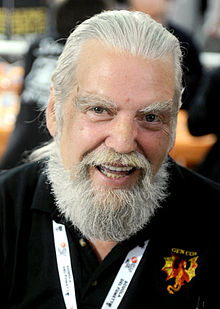TSR, Inc.
In the mid-1970s, Mentzer and a friend taught themselves how to play the new role-playing game Dungeons & Dragons, and he became part of a group of eight to twelve players who played several times a week. In 1979, TSR, the company that published D&D, advertised for a designer and an editor. Although Mentzer was initially uninterested since he had no editorial or design experience, fellow player David Axler, who would go on to write an article for the December 1981 issue of Dragon magazine about how to determine the weather in the World of Greyhawk campaign setting, —urged him to apply. Mentzer finally relented and after a phone interview with TSR, he was hired for the editorial position, Tom Moldvay was hired as the new designer, and in January 1980, Mentzer moved to Lake Geneva, Wisconsin.
Soon after joining TSR, he was invited to participate in TSR's first "DM Invitational", a contest to choose D&D's best overall dungeon master; other contestants included Len Lakofka and Erol Otus. At Gen Con 1980, it was announced that Mentzer was the winner, and he was awarded a silver cup and a gold dragon chain of office. Mike Carr of TSR had been contemplating starting a TSR-sponsored D&D fan club. Shortly after Mentzer won the DM Invitational, Carr approached him about taking on that task. Mentzer agreed to form some sort of group but, rather than a simple fan club, he was interested in promoting better quality role-playing, especially during scored D&D events at conventions. Mentzer felt that the system as it stood rewarded those players that stayed quiet at the table, in effect punishing good role-players. He came up with a scoring system where the dungeon master and the players all voted on who had been the best role-player at the table. With this in place, Mentzer formed the Role Playing Game Association (RPGA), an organization that would promote quality role-playing and allow fans of role-playing games to meet and play games with each other. : 13 Mentzer wrote four RPGA tournament adventures set in his home campaign setting of "Aquaria", which he had been running since 1976; : 24 these were published by TSR as the first four of the R-series modules: R1 To the Aid of Falx, R2 The Investigation of Hydell, R3 The Egg of the Phoenix, and R4 Doc's Island. Mentzer envisioned them as becoming a part of Gary Gygax's World of Greyhawk setting, the first part of a new "Aqua-Oeridian" campaign set somewhere on Oerth outside of the Flanaess. (The connection between Aquaria and Greyhawk was never made, but these four modules were later revised by Mentzer and Paul Jaquays and re-published as the "super-module" I12 Egg of the Phoenix in 1989.)
In his review of Egg of the Phoenix, Ken Rolston called Mentzer "a clever and original designer", and said that of all of the better-known adventure designers of the time he: "comes closest to creating scenarios in which the protagonists behave as if the game's rule books were physics texts describing the laws governing the workings of the universe".
Mentzer became involved with the auction of hobby gaming materials at Gen Con in 1983,[citation needed] and was involved with what is now called the world's largest game auction every year until retiring after Gen Con 50 in 2017.[citation needed]
Mentzer was soon promoted to Creative Director at TSR, and one of the tasks he was given was to collate and revise the various rules sets for Basic D&D in such a way that no rules, monsters, or other material that had been developed specifically for Advanced Dungeons & Dragons (AD&D), were borrowed. Mentzer's third edition of the D&D Basic Set (1983) was used to launch a series of five rules boxed sets that ultimately allowed characters to advance from first level to godhood. : 15 This resulted in the Expert (1984), Companion (1984), Master (1985), and Immortals (1986) boxed sets of D&D rules - collectively known as BECMI. These were eventually translated into eleven languages, and millions were sold worldwide.
Mentzer's other work included: IM-1 The Immortal Storm (1986), I-11 Needle (1987), and an adventure module for TSR's Star Frontiers game based on Arthur C. Clarke's novel 2001: A Space Odyssey. Because of his work with the Gen Con game auction, Mentzer had become interested in the game memorabilia market, and along with James Ward and Jean Black, wrote The Game Buyers' Price Guide 1986, which summarized current market prices for hobby games. Further annual editions were planned, but when Mentzer left TSR, the project was shelved.
Mentzer expanded Gary Gygax's Village of Hommlet adventure into the adventure module T1-4 The Temple of Elemental Evil (1985), the first of a new format of 96-page to 128-page squarebound paperback supplements, which allowed more space to detail settings and adventures. : 18 Mentzer worked closely with Gygax on that module, as well as the accessory The Book of Marvelous Magic (1985).
